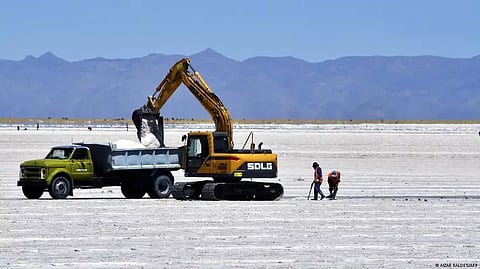

By Eugen Theise
WASHINGTON: Dig into the earth near the Ukrainian city of Dniprorudne, and you’ll hit ore with an iron content of over 60%. Before the war, about 4.5 million tons of this high-quality iron ore were mined each year — with the lion’s share exported to Slovakia, the Czech Republic and Austria. Selling this strategically important resources earned Dniprorudne mines the equivalent of $216 million per year. One-third of the ore was made into steel at a plant to the west, in the city of Zaporizhzhia, and also exported.
But all that changed in the summer of 2022, when Russian troops occupied Dniprorudne. Ukraine’s highly coveted and strategically important natural resources are now being sent to Russia. Ukrainian, Slovak and Czech investors in the mining business have had their property seized by Russia.
Metallurgy ore exports fell by nearly 60% in 2022 from 2021, dropping to a total value of less than $3 billion (2.8 billion euros), according to industry analysts GMK Center, a Ukraine-based think tank. Part of this drop is attributed to Russia’s occupation of Ukrainian mining regions. In 2022, the Canadian think tank SecDev estimated the total value of deposits in occupied Ukraine at over $12 trillion.
In addition to iron ore, key resources such as coal, titanium and manganese are found in Ukraine. Gold, natural gas, oil, kaolinite, salt, gypsum, zirconium and uranium are also present. The country’s largest iron ore deposit, the Kryvyi Rih basin, remains under Ukrainian control, and so do its processing combines. Yet this region is systematically shelled from nearby territories under Russian control.
“Moscow’s political plan is primarily to destroy Ukraine’s economic potential,” Yaroslav Zhalilo, an economic analyst with Kyiv’s National Institute for Strategic Studies, told DW. “To do that, it doesn’t matter whether you seize resources or destroy them through shelling.”
Zhalilo said the resource shortage was having dramatic consequences for Ukrainian steel production. While Ukraine exported almost 20 million tons of metallurgical products in 2021, that figure dropped to just 2.5 million tons in the first half of 2023, which, if extrapolated for the entire year, would indicate a 80% drop. Russian troops destroyed major Ukrainian steel mills when they conquered Mariupol, and those that remain are now struggling to stay operational.
About 80% of Ukrainian coal deposits are located in Russian-occupied regions. All of Ukraine’s anthracite, or black coal, which has a high energy density, is presently under Russian control. This means that Ukraine is forced to import coal from countries such as the United States and South Africa. These imports are particularly costly because of the Russian blockade of Ukrainian Black Sea ports. So, instead, the resources brought to ports in neighboring Poland or Romania and then transported onward by rail.
These logistical problems also complicate the export of goods, undermining Ukraine’s industrial competitiveness. “Russia wants to bleed Ukraine’s economy dry and portray the country as a ‘failed state’ that cannot survive without Russia,” Zhalilo said. Seizing Ukraine’s natural resources was one of Russia’s key motives for launching the invasion, Olivia Lazard of the Brussels-based Carnegie Europe think tank told DW. She said using force to gain control of strategically important resources was a recurring theme in Russian foreign policy.